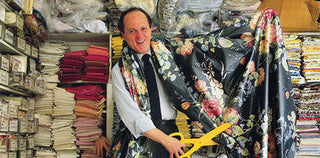Affectionately known as the “Prince of Chintz”, the legendary Mario Buatta is credited with creating the so-called “American English Country House style”. He was known for an eccentric, outsized personality, which flowed into his exuberantly colorful interiors, and “when the decorator was in top form, few could resist his madcap charm”.1
Buatta would show up to fancy parties in a fake wig and eyeglasses 50 times too big and was a well-known prankster. A Mario Buatta room overflowed with color, patterns, especially his beloved Lee Jofa floral chintzes, lacquered walls, and antiques and collected items. He felt that rooms should develop over time, adding bits and pieces to create a perfect whole. He felt interiors lacking collected pieces of the home owners and the patina of antiques had no soul.

Photo: Architectural Digest
A native New Yorker, Mario Buatta was born on Staten Island and studied architecture briefly at Wagner College and Cooper Union, later studying design at Pratt Institute, Columbia University, and Parsons School of Design.2
After brief stints with the department store B. Altman and Company and the decorator Elisabeth Draper, he opened this own design business in 1963. A year later during a trip to London, he met the decorator John Fowler, of Colefax & Fowler. The encounter was incredibly influential on Buatta’s work. Fowler’s innate taste, sense of color, and knowledge of historic interiors embodied Buatta’s ideal of eclectic, colorful, collected interior design. Upon his return to the States, Buatta was inspired to bring the English country house look to the US, but he “adapted the concept to suit the apartment living of New York. He saturated walls in colour and chose flowered fabrics and ceramics that were suggestive of gardens and parks. ‘It was a dream of England,’ says decorator Nicky Haslam.3
According to design historian Emily Evans Eerdmans, Buatta did not claim to be original, but he thought of his rooms as backdrops for his clients to live their best lives, and so to those rooms he brought color, comfort and beauty, all with his trademark humor.4
Buatta made his home on the Upper East Side of Manhattan on E. 80th St in a townhouse originally owned by and still known as the George and Martha Whitney House. It was famously off-limits to guests, and Buatta seemed to prefer to live in “exotic disarray”, referring to himself, with his passionate collecting habits, as “the original hoarder” in a 2013 New York Times article.5
Over the course of five decades, Mario Buatta worked with clients including Barbara Walters, Mariah Carey, Henry Ford II, Nelson Doubleday, Malcolm Forbes, Billy Joel and Nancy Reagan. In 1988, Mario Buatta and Mark Hampton were engaged to reimagine the rooms of Blair House, the official guest house for distinguished dignitaries in Washington, diagonally across the street from the White House. They incorporated three generations of Blair family furnishings with their own eclectic Anglo-American styles. Mr. Buatta’s rooms were easily identifiable by his fondness for chintz fabric (the printed cotton fabric with a glazed finish), and “exuberant use of pillows, fringes, swags, tassels, bows and ruffles.”6
 Photo: Gabby Jones
Photo: Gabby Jones
Buatta died October 15, 2018. In January of 2020, Sotheby’s hosted an auction of Buatta’s private apartment. The auction, titled “Mario Buatta: Prince of Interiors” encompassing all those items he collected over the years with such passion - Delftware, Staffordshire, masses of dog portraits (which Buatta humorously called his “ancestral paintings”), to name but a few. In Mario Buatta’s world, more is always more.
1 & 5Mason, Christopher. Remembering the Marvelous, Maddening Mario Buatta. The New York Times. October 20, 2018. Retrieved 2021-03-17
2https://en.wikipedia.org/wiki/Mario_Buatta. Wikipedia. Retrieved 2021-03-17
3 & 4Adeane, Olinda. Mario Buatta, the Marvellous Master of More. Sothebys.com. January 3, 2020. Retrieved 2021-03-17
6Nemy, Enid. https://www.nytimes.com/2018/10/16/obituaries/mario-buatta-dead.html The New York Times. October 16, 2018. Retrieved 2021-03-17.

